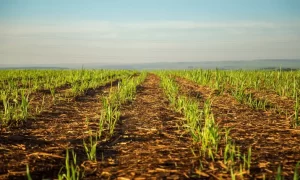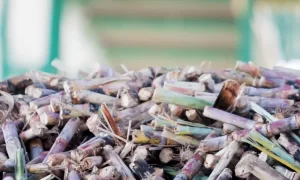Sugar Cane Plant – Profile & Cultivation in the Garden: Sugar cane provides 70 percent of the world’s sugar needs and captivates with a magnificent appearance. The sugar cane plant combines utility and beauty in such an impressive way that its cultivation in the ornamental garden is recommended as a fascinating project. Although the following fact sheet characterizes sugarcane as a tropical plant, cultivation in one’s own garden is quite possible, provided that some fundamental guidelines are taken to heart. In this article, we will show how to plant sugar cane & how to take proper care of sugar cane. What these are and how the cultivation of the exotic gem succeeds, you will learn here.
Contents
- Profile
- How to Plant Sugar Cane?
- Growing From Seed
- Growing From Cuttings
- Cultivation in the Garden
- Care
- Harvesting and pruning
- Wintering
- Repot
- Final Thought: How to Plant Sugar Cane?
- What is the best time to plant sugar cane?
- Is Sugar Cane easy to grow?
- How deep should sugar cane be planted?
- Does sugarcane need lots of water?
Profile
- A plant family of the sweet grasses (Poaceae).
- The scientific name of the sugar cane plant: Saccharum officinarum.
- Native to the tropics and subtropics.
- Perennial and herbaceous in growth.
- Minimum temperature: 3 to 5 degrees Celsius.
- Height of growth in culture from 150 to 300 cm.
- Diameter of the culms from 20 to 50 mm.
- Panicle flowering from 40 to 60 cm in length in autumn.
- Root system: underground shoot axes (rhizomes).
- Worldwide use for the production of household sugar.
The plant residues of sugar cane after harvesting are further processed into livestock feed, fuel and serve as a basic material for paper production. In addition, sweetgrass is increasingly used to produce biofuel and electricity.
How to Plant Sugar Cane?
Growing From Seed
How to grow sugar cane from seed? Well, if you want to experience their growth from the ground up, you can choose to grow them from seed. High-quality seeds are available all year round from specialist dealers. Provided, a piece of equipment
is available that creates a tropically warm environment for the seeds, sowing proceeds in the following steps:
- Fill a thermos with lukewarm water and soak the seeds in it overnight.
- Fill pots with lean seeding soil, peat sand, or uniform soil and sprinkle with water.
- Place one seed per seed pot on the substrate to just press on the light sprout.
- Cover with transparent film put a glass plate or move to the heated mini-greenhouse.
At a constant temperature of 22 to 25 degrees Celsius, the cotyledons break their way through the seed coat within 21 days. Any cover has then done its job and is removed so that the seedling does not bump into it. During this time, the substrate must neither dry out nor become completely soaked. Fertilizer is not yet given to the future sugar canes at this stage.
Growing From Cuttings
Growing sugarcane from cuttings is another way. Less complicated than sowing and with a higher success rate proves to be the cultivation of sugarcane from cuttings. For this you need one or more mature stalks, cut into pieces with 2 to 4 eyes, also called nodes. For the plant to grow vertically in the course of cultivation, the cuttings must be positioned horizontally on the substrate. How to do it correctly:
- Fill pots with at least 5 liters of volume with growing or pricking out the soil.
- Place one cutting per propagation container in the substrate and cover with soil to a maximum height of 15 cm.
- Place in an indoor greenhouse that maintains a temperature level of 25 to 28 degrees.
Ideally, water the sugarcane cuttings from below. To do this, fill a tub about 10 cm high with water as low in lime as possible and place the pots in it. Due to capillary force, moisture will be drawn into the substrate. If the surface feels damp, remove the pots from the water and move them into a warm mini-greenhouse or the garden. Under warm tropical conditions, vertical shoots will sprout from the nodes within 2 to 4 weeks, while their root system develops in the substrate.
Read more about How to plant fruit trees?
Cultivation in the Garden
How to plant sugar cane in your garden? Since the sugar cane plant is a tropical plant, in the Central European climate is primarily considered cultivation in the tub. If temperatures drop below 5 degrees Celsius, the plant dies. Grown in a container, the imposing ornamental grass spends the summer on the balcony, terrace, or seating area, to be put away in time for winter. The planting season begins in mid to late May.
- Place the root balls of the pre-pulled sugar cane plants in low-lime water.
- Meanwhile, fill a large tub with 20-40 liters of volume with potting soil or garden soil-compost mixture.
- Enrich the substrate with sand, Styrofoam flakes, or lava granules to improve permeability.
- Beforehand, create drainage above the soil opening from pebbles, chippings, or shards of clay.
- Pot out the water-soaked young plant and plant it in the new pot at the same depth as before.
- Leave a watering rim of 5 centimeters free and water generously.
Place the pot in a sunny to a semi-shaded, warm and sheltered location in the garden. Within a few weeks, the sugarcane will have reached its final size. After 4 months, the stalks will be mature for a first harvest.
Tip: Plant sugarcane in a large pot with handles and sink it into the soil in a suitable location in the garden. In the fall, simply bring the pot back out of the ground to put the plant away.
Care
In the proper care of sugar cane, it is important to balance water and nutrients. Water the plant regularly with collected rainwater or decalcified tap water. The sunnier the location, the higher the evaporation rate due to the powerful biomass. Therefore, check daily by thumb test the moisture requirement. From June to September, apply an organic liquid fertilizer weekly. Alternatively, guano sticks or organic fertilizer cones provide nutrients, especially if the stalks are grown to produce sugar for consumption. If the sugarcane plant is used solely for ornamental purposes, the application of slow-release mineral fertilizer may also be considered, in March, May, and July for established specimens.
Harvesting and pruning
As summer draws to a close, the culms are ready for harvest about 4 months after planting. Before putting them away, cut individual culms or the entire plant close to the ground. Pressed
obtain 1 glass of sugarcane juice from 1 meter of stalk on average. This juice is already suitable for consumption. Optionally, the molasses is filtered and heated until ultimately the sugar crystals remain. Unless a harvest is sought, the stalks remain on the plant through the winter.
Tip: If a sugar cane plant is getting on in years, use a healthy culm to obtain cuttings. In this way, you will propagate the tropical grass in time before it loses its beauty.
Wintering
If temperatures fall permanently below 10 degrees Celsius, the time has come for the move from the garden to the winter quarters. To do this, choose a bright room that ensures constant warmth of at least 15 degrees Celsius. In a cooler environment, the stalks will die unless they have been harvested. In early spring, cut out all withered parts of the plant to make room for young shoots. Care during the cold season is limited to the following measures:
- Keep the substrate slightly moist, adapted to the reduced water needs.
- Do not apply fertilizer from October to February.
- To prevent spider mites, spray the sugarcane with lime-free water from time to time.
Repot
Repotting sugar cane is very important. The pronounced vigor of sugar cane requires an annual change to a larger tub. The best time for this maintenance measure is early spring. At the latest when the rhizomes are pushing up through the substrate or growing out of the soil opening, repotting should be tackled. How to do it:
- The new pot is at least 10 inches larger in diameter.
- Above the water, spread drainage of inorganic, coarse materials.
- A mix of pot plant soil, expanded clay, and sand is recommended as substrate.
- First, fill the new pot halfway with fresh potting soil and press a depression into it with your fist. After that, the sugarcane plant is potted out to be planted in the middle and watered. It is important to note that the sweetgrass should not be placed deeper than before, so as not to cause rot. Repotted in pre-fertilized soil, sugarcane will not receive its first fertilizer ration for at least 6 weeks.
Final Thought: How to Plant Sugar Cane?
Sugarcane cultivation is by no means limited to tropical regions. So if you want to know how to plant sugar cane, you should take into account the special requirements for adequate light and temperature conditions, the exotic sweetgrass also thrives in the Central European climate. It is necessary to observe a temperature minimum of 5 degrees and provide a bright, warm winter quarter. Then there is nothing against the cultivation of the imposing plant in the garden.
Learn more about How to plant peas?
Frequently Answered Questions
What is the best time to plant sugar cane?
The best time according to experts, to plant sugar cane is between September to November. So that the sprouting will start in early spring.
Is Sugar Cane easy to grow?
Yes, Sugar cane is pretty much easy to grow. Also, it is fairly easy to harvest and process into something very delicious and gift-worthy.
How deep should sugar cane be planted?
You should dig a 3 inches’ deep trench and make sure it’s at least 4 inches wide for the cane. Also, keep 4 inches gap between the trench if you want more than one row.
Does sugarcane need lots of water?
Yes. As it is a tall tropical plant, it needs enough sunlight, lots of water, and fertile soil.




